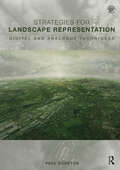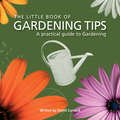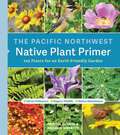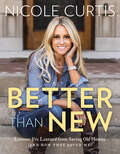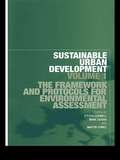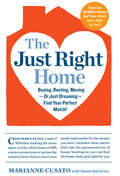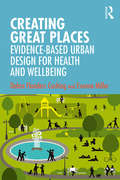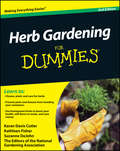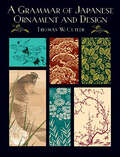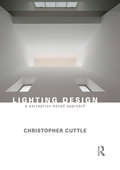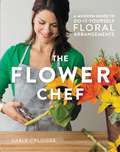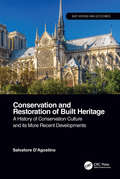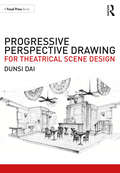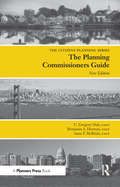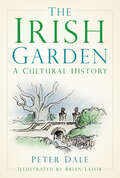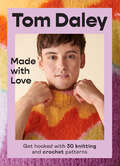- Table View
- List View
Strategies for Landscape Representation: Digital and Analogue Techniques
by Paul CuretonStrategies for Landscape Representation discusses a variety of digital and analogue production techniques for the representation of landscape at multiple scales. Careful consideration is required to represent time, and to ensure accuracy of representation and evaluation in the landscape.Written as a guide for making appropriate selection of a wide variety of visualisation tools for students and built environment professionals with an interest in landscape, the book charts emerging technologies and historical contexts whilst also being relevant to landscape legislation such as Building Information Modelling (BIM) and Landscape Assessment. This book is an innovation-driven text that encourages readers to make connections between software, technology and analogue modes. The management, choice and combination of such modes can arguably narrow the unknown of landscape character, address the issues of representing time and change in landscape and engage and represent communities’ perceptions and experience of landscape.Showcasing international examples from landscape architecture, planning, urban design and architecture, artists, visualisers, geographers, scientists and model makers, the vitality of making and intrinsic value of representational work in these processes and sites is evidenced. An accompanying companion website provides access to original source files and tutorials totalling over a hundred hours in mapping and GIS, diagrams and notation, photomontage, 3D modelling and 3D printing.
Strategies for Landscape Representation: Digital and Analogue Techniques
by Paul CuretonStrategies for Landscape Representation discusses a variety of digital and analogue production techniques for the representation of landscape at multiple scales. Careful consideration is required to represent time, and to ensure accuracy of representation and evaluation in the landscape.Written as a guide for making appropriate selection of a wide variety of visualisation tools for students and built environment professionals with an interest in landscape, the book charts emerging technologies and historical contexts whilst also being relevant to landscape legislation such as Building Information Modelling (BIM) and Landscape Assessment. This book is an innovation-driven text that encourages readers to make connections between software, technology and analogue modes. The management, choice and combination of such modes can arguably narrow the unknown of landscape character, address the issues of representing time and change in landscape and engage and represent communities’ perceptions and experience of landscape.Showcasing international examples from landscape architecture, planning, urban design and architecture, artists, visualisers, geographers, scientists and model makers, the vitality of making and intrinsic value of representational work in these processes and sites is evidenced. An accompanying companion website provides access to original source files and tutorials totalling over a hundred hours in mapping and GIS, diagrams and notation, photomontage, 3D modelling and 3D printing.
Little Book of Gardening Tips (The\little Book Ser.)
by David CurnockThe Little Book of Gardening Tips is written by David Curnock and is a 96-page hardback book. It is aimed at the amateur gardener who, whilst interested in gardening, is often put off buying gardening books because of their size and often heavy content. This little book contains all the best seasonal gardening tips to help even the least green-fingered person! Packaged with beautiful photographs it is an ideal starter book.
The Pacific Northwest Native Plant Primer: 225 Plants for an Earth-Friendly Garden
by Kristin Currin Andrew MerrittNative plants bring your garden to life—and life to your garden! Here are the best choices for Oregon and Washington. The benefits of native plants are enormous—they reduce maintenance, require less water, and attract vital, earth-friendly pollinators like birds, butterflies, and bees. Gardeners seeking to add them to their landscape will find no better guide than The Pacific Northwest Native Plant Primer. Packed with proven advice that everyhome gardener can follow, this incomparable sourcebook profiles 225 recommended native wildflowers, grasses and grasslike plants, ferns, shrubs, and trees. With additional introductory information on preparation, planting, maintenance, and climate considerations, it&’s everything you need to know to create a beautiful and beneficial garden. This must-have handbook is for gardeners in Oregon, Washington, and southern British Columbia.
Better Than New: Lessons I've Learned from Saving Old Homes (and How They Saved Me)
by Nicole CurtisA New York Times and USA Today Bestseller For the first time, Nicole Curtis, the star of the megahit HGTV and DIY Network show Rehab Addict, reveals her private struggles, her personal victories, and the inspiring lessons we can all learn from them. Nicole Curtis is the tough, soulful, charismatic dynamo who for the past twenty years has worked tirelessly to restore historical houses, often revitalizing neighborhoods in the process. And also, in the process, drawing millions of fans to her television show, Rehab Addict, where they follow each step of the hard work and singular vision that transform the seemingly lost cause of a run-down building into a beautifully restored home. But there is so much more to this self-taught expert and working mom. With hersignature irresistible honesty and energy, Curtis writes about a project that every reader will find compelling: how she rehabbed herself. Better Than New reveals what&’s not seen on TV—Curtis&’s personal battles and her personal triumphs, her complicated relationships, her life as a single mother, the story of how she got started remodeling houses, and the consuming ins and outs of producing a megahit television show while keeping up with two kids, two rescue dogs, and countless tasks on her home renovation punch lists. Followers of the show will get an inside look at some of her most famous restorations, including the Dollar house, the Minnehaha house, the Campbell Street project, and the Ransom Gillis mansion. Part inspirational memoir and part self-help guide, Better Than New is a journey ineight chapters—each pinned to the story of a house that Curtis has remodeled, each delivering a hard-fought lesson about life—that takes readers to the place we all want to be: home.
Sustainable Urban Development Volume 1: The Framework and Protocols for Environmental Assessment (Sustainable Urban Development Series)
by Stephen Curwell Mark Deakin Martin SymesBased on original research, this first volume of a set of groundbreaking new books sets out a framework for analyzing sustainable urban development and develops a set of protocols for evaluating the sustainability of urban development. Protocols included are for sustainable urban planning, urban property development, urban design, the construction, operation and use of buildings. Using these protocols, the book goes on to provide a directory of environmental assessment methods for evaluating the sustainability of urban development and also maps out how these assessment methods are being transformed to evaluate the environmental, economic and social sustainability of urban development. Web-based applications are increasingly being used to support this transformation and the contributors deftly cover this application and issues concerning the use of information and communication technologies for evaluating the sustainability of urban development are also dealt with. With its multidisciplinary approach, Sustainable Urban Development presents key new material for postgraduates and professionals across the built environment.
Sustainable Urban Development Volume 1: The Framework and Protocols for Environmental Assessment (Sustainable Urban Development Series #Vol. 1)
by Steven Curwell Mark Deakin Martin SymesBased on original research, this first volume of a set of groundbreaking new books sets out a framework for analyzing sustainable urban development and develops a set of protocols for evaluating the sustainability of urban development. Protocols included are for sustainable urban planning, urban property development, urban design, the construction, operation and use of buildings. Using these protocols, the book goes on to provide a directory of environmental assessment methods for evaluating the sustainability of urban development and also maps out how these assessment methods are being transformed to evaluate the environmental, economic and social sustainability of urban development. Web-based applications are increasingly being used to support this transformation and the contributors deftly cover this application and issues concerning the use of information and communication technologies for evaluating the sustainability of urban development are also dealt with. With its multidisciplinary approach, Sustainable Urban Development presents key new material for postgraduates and professionals across the built environment.
The Just Right Home: Buying, Renting, Moving--or Just Dreaming--Find Your Perfect Match!
by Marianne CusatoThirty-seven million Americans move during any given year. Millions more think about it. They all want the same thing—a perfect place to live. But most of us have only the vaguest idea of what makes us happy, home-wise, and don’t even know all the questions to ask. That’s where Marianne Cusato comes in. One of the most influential people in the home-building industry, designer of the Katrina Cottages, and go-to authority for the media on issues related to housing, she’s written a comprehensive, interactive guide to finding the just right home. This is the book that answers the plea she hears every time she gives a speech—“I wish I’d talked to you before buying my house!”By leading the reader through every step of choosing a home—from the broad strokes, such as city vs. suburb and buy vs. rent, to specific details of energy use and building materials—The Just Right Home helps readers understand not only what they want in a home but what they need. It shows why proximity—to work, to stores, to schools—trumps location, and what the difference means. Why a property’s live-in value is greater than its resale value. How to identify and assess the big three variables: function, cost, delight. How to get a realistic grip on budget, including factoring in maintenance costs. How to plan for future needs—children moving out, a parent moving in, or just growing old in a home. Why all square feet are not created equal. The ins and outs of zonings, covenants, home-owner associations. The five elements to look for when walking through a property. How much to pay an inspector. And so much more.Filled with sidebars, boxes, examples, anecdotes, and cheat sheets, it’s the book that helps readers answer all their questions about where to live and what to live in.
Creating Great Places: Evidence-based Urban Design for Health and Wellbeing
by Debra Flanders Cushing Evonne MillerThis book provides a bold vision and roadmap for creating great places. Imagining and designing urban environments where all people thrive is an extraordinary task, and in this compelling narrative, Cushing and Miller remind us that theory is a powerful starting point. Drawing on international research, illustrated case studies, personal experiences, as well as fascinating examples from history and pop culture, this practical book provides the reader with inspiration, guidance and tools. The first section outlines six critical theories for contemporary urban design - affordance, prospect-refuge, personal space, sense of place/genius loci, place attachment, and biophilic design. The second section, using their innovative ‘theory-storming’ process, demonstrates how designers can create great places that are inclusive, sustainable, and salutogenic. Creating Great Places is an insightful, compelling, and evidence-based resource for readers who want to design urban environments that inspire, excite, and positively transform people’s lives.
Creating Great Places: Evidence-based Urban Design for Health and Wellbeing
by Debra Flanders Cushing Evonne MillerThis book provides a bold vision and roadmap for creating great places. Imagining and designing urban environments where all people thrive is an extraordinary task, and in this compelling narrative, Cushing and Miller remind us that theory is a powerful starting point. Drawing on international research, illustrated case studies, personal experiences, as well as fascinating examples from history and pop culture, this practical book provides the reader with inspiration, guidance and tools. The first section outlines six critical theories for contemporary urban design - affordance, prospect-refuge, personal space, sense of place/genius loci, place attachment, and biophilic design. The second section, using their innovative ‘theory-storming’ process, demonstrates how designers can create great places that are inclusive, sustainable, and salutogenic. Creating Great Places is an insightful, compelling, and evidence-based resource for readers who want to design urban environments that inspire, excite, and positively transform people’s lives.
Herb Gardening For Dummies
by Karan Davis Cutler Kathleen Fisher Suzanne DeJohn National Gardening AssociationA plain-English guide to the world of herb gardening Starting an herb garden isn't free, but it certainly outweighs the growing costs of buying retail herbs. Plus, adding homegrown ingredients to your meals is a healthy and tasty way to improve upon any dish you whip up at home. This friendly, hands-on guide is an excellent introduction to the world of herb gardening. It gives you tips and advice to grow a thriving herb garden that will add depth and flavor to home-cooked meals-as well as boost your health. How to choose, plant, and care for herbs Covers ready-made versus homemade soil mixes, starting plants from seeds, and other fundamentals How to prevent insects, pests, and diseases from invading your containers Over 30 herb recipes for everyday uses, including rubs, marinades, beauty products, and more Whether you're interested in getting step-by-step instructions for starting on your first herb garden or already have one and want to learn new tips and techniques, Herb Gardening For Dummies, 2nd Edition has you covered!
Herb Gardening For Dummies
by Karan Davis Cutler Kathleen Fisher Suzanne DeJohn National Gardening AssociationA plain-English guide to the world of herb gardening Starting an herb garden isn't free, but it certainly outweighs the growing costs of buying retail herbs. Plus, adding homegrown ingredients to your meals is a healthy and tasty way to improve upon any dish you whip up at home. This friendly, hands-on guide is an excellent introduction to the world of herb gardening. It gives you tips and advice to grow a thriving herb garden that will add depth and flavor to home-cooked meals-as well as boost your health. How to choose, plant, and care for herbs Covers ready-made versus homemade soil mixes, starting plants from seeds, and other fundamentals How to prevent insects, pests, and diseases from invading your containers Over 30 herb recipes for everyday uses, including rubs, marinades, beauty products, and more Whether you're interested in getting step-by-step instructions for starting on your first herb garden or already have one and want to learn new tips and techniques, Herb Gardening For Dummies, 2nd Edition has you covered!
A Grammar of Japanese Ornament and Design
by Thomas W. CutlerThe lovely images in this rare collection comprise one of the most comprehensive surveys of mid-19th-century Japanese art and ornamentation. Included are graceful details from landscapes, floral motifs, abstracts, illustratons of sea life, and other subjects-ideal for use in a host of art and craft projects. Over 300 figures on 65 plates.
Lighting Design: A Perception-Based Approach
by Christopher CuttleBy reading this book, you will develop the skills to perceive a space and its contents in light, and be able to devise a layout of luminaires that will provide that lit appearance. Written by renowned lighting expert Christopher (Kit) Cuttle, the book: explains the difference between vision and perception, which is the distinction between providing lighting to make things visible, and providing it to influence the appearance of everything that is visible; demonstrates how lighting patterns generated by three-dimensional objects interacting with directional lighting are strongly influential upon how the visual perception process enables us to recognize object attributes, such as lightness, colourfulness, texture and gloss; reveals how a designer who understands the role of these lighting patterns in the perceptual process may employ them either to reveal, or to subdue, or to enhance the appearance of selected object attributes by creating appropriate spatial distributions of light; carefully explains calculational techniques and provides easy-to-use spreadsheets, so that layouts of lamps and luminaires are derived that can be relied upon to achieve the required illumination distributions. Practical lighting design involves devising three-dimensional light fields that create luminous hierarchies related to the visual significance of each element within a scene. By providing you with everything you need to develop a design concept - from the understanding of how lighting influences human perceptions of surroundings, through to engineering efficient and effective lighting solutions – Kit Cuttle instills in his readers a new-found confidence in lighting design.
Lighting Design: A Perception-Based Approach
by Christopher CuttleBy reading this book, you will develop the skills to perceive a space and its contents in light, and be able to devise a layout of luminaires that will provide that lit appearance. Written by renowned lighting expert Christopher (Kit) Cuttle, the book: explains the difference between vision and perception, which is the distinction between providing lighting to make things visible, and providing it to influence the appearance of everything that is visible; demonstrates how lighting patterns generated by three-dimensional objects interacting with directional lighting are strongly influential upon how the visual perception process enables us to recognize object attributes, such as lightness, colourfulness, texture and gloss; reveals how a designer who understands the role of these lighting patterns in the perceptual process may employ them either to reveal, or to subdue, or to enhance the appearance of selected object attributes by creating appropriate spatial distributions of light; carefully explains calculational techniques and provides easy-to-use spreadsheets, so that layouts of lamps and luminaires are derived that can be relied upon to achieve the required illumination distributions. Practical lighting design involves devising three-dimensional light fields that create luminous hierarchies related to the visual significance of each element within a scene. By providing you with everything you need to develop a design concept - from the understanding of how lighting influences human perceptions of surroundings, through to engineering efficient and effective lighting solutions – Kit Cuttle instills in his readers a new-found confidence in lighting design.
The Flower Chef: A Modern Guide to Do-It-Yourself Floral Arrangements
by Carly CylinderTHE FLOWER CHEF is a modern, comprehensive guide to floral design that caters to all readers--from beginners who have never worked with flowers before and are looking for a new creative outlet, to decorators, party planners and photographers looking to liven up their spaces. Even professionals will find ways to update their techniques! This book teaches you everything you need to know about flower arranging including tips on how to buy and care for flowers, how to cut and prepare them, and how to use floral foam, vases, and various other decorative elements in your arrangements. Filled with beautiful photographs and easy-to-follow instructions on how to create over 80 different arrangements, this is the go-to guide to floral design that every flower lover will want to add to their collection.
The Flower Chef: A Modern Guide to Do-It-Yourself Floral Arrangements
by Carly CylinderRevel in this modern and comprehensive guide to floral design with "Gorgeous frameable images" and step-by-step instructions to bring your guardian inside (Laurie March).The Flower Chef is a modern, comprehensive guide to floral design that caters to all readers--from beginners who have never worked with flowers before and are looking for a new creative outlet, to decorators, party planners and photographers looking to liven up their spaces. Even professionals will find ways to update their techniques! This book teaches you everything you need to know about flower arranging including tips on how to buy and care for flowers, how to cut and prepare them, and how to use floral foam, vases, and various other decorative elements in your arrangements. Filled with beautiful photographs and easy-to-follow instructions on how to create over 80 different arrangements, this is the go-to guide to floral design that every flower lover will want to add to their collection.
Conservation and Restoration of Built Heritage: A History of Conservation Culture and its More Recent Developments (Built Heritage and Geotechnics)
by Salvatore D'AgostinoThe word conservation, when used in the context of the preservation of built heritage, implies an intrinsically complex concept that evolved over time, since it has been influenced by the perception of history throughout time. This volume emphasises why an understanding of the cultural evolution of the conservation approach must be considered a prerequisite for architects and engineers if they are to cooperate in full harmony with historic-artistic culture for the preservation of global built heritage. In particular, the volume highlights how, during the second half of the last century, the preservation process also involved engineering – the science of making practical applications of knowledge – which, for a long time, made an uncritical use of techniques and materials and devised interventions on historical heritage that were heavily invasive. The volume also devotes special attention to the problems related to seismic risk, to which Italy, Greece and Portugal are particularly prone. Problems that emerge during the crisis and reconstruction phases are dealt with in detail, as is scheduled maintenance, as this latter approach always constitutes an improvement in the performance of the monument and is the most appropriate tool for the conservation of the built heritage. Finally, the volume collects examples of building restoration with case studies of many outstanding monuments. The work will appeal to professionals and academics in the broader fields of civil engineering (both geotechnical and structural engineering), architecture, art history, the history of architecture, restoration and cultural heritage management. This book will: Provide a critical reading of the history of conservation; Discuss materials and techniques of ancient architecture; Cover seismic vulnerability and preservation of the historic integrity of the monument; Advocate an approach based on programmed maintenance; Feature numerous case histories, including St Mark’s Basilica in Venice and the complex restoration of the cathedral of Notre-Dame in Paris.
Conservation and Restoration of Built Heritage: A History of Conservation Culture and its More Recent Developments (Built Heritage and Geotechnics)
by Salvatore D'AgostinoThe word conservation, when used in the context of the preservation of built heritage, implies an intrinsically complex concept that evolved over time, since it has been influenced by the perception of history throughout time. This volume emphasises why an understanding of the cultural evolution of the conservation approach must be considered a prerequisite for architects and engineers if they are to cooperate in full harmony with historic-artistic culture for the preservation of global built heritage. In particular, the volume highlights how, during the second half of the last century, the preservation process also involved engineering – the science of making practical applications of knowledge – which, for a long time, made an uncritical use of techniques and materials and devised interventions on historical heritage that were heavily invasive. The volume also devotes special attention to the problems related to seismic risk, to which Italy, Greece and Portugal are particularly prone. Problems that emerge during the crisis and reconstruction phases are dealt with in detail, as is scheduled maintenance, as this latter approach always constitutes an improvement in the performance of the monument and is the most appropriate tool for the conservation of the built heritage. Finally, the volume collects examples of building restoration with case studies of many outstanding monuments. The work will appeal to professionals and academics in the broader fields of civil engineering (both geotechnical and structural engineering), architecture, art history, the history of architecture, restoration and cultural heritage management. This book will: Provide a critical reading of the history of conservation; Discuss materials and techniques of ancient architecture; Cover seismic vulnerability and preservation of the historic integrity of the monument; Advocate an approach based on programmed maintenance; Feature numerous case histories, including St Mark’s Basilica in Venice and the complex restoration of the cathedral of Notre-Dame in Paris.
Progressive Perspective Drawing for Theatrical Scene Design
by Dunsi DaiProgressive Perspective Drawing for Theatrical Scene Design provides theatrical scenic designers with the tools to create quick and precise perspective drawings. The book explores three methods of perspective drawings at progressive skill levels – the Grid Method, the Frame Method, and the Freehand with References Method – allowing scenic designers to build on their drawing technique consistently. Replete with discussions on pencil techniques, step by step instructions, and set sketches from professional set design projects, this volume guides readers from the basics of the cube system to the more challenging freehand drawing. Progressive Perspective Drawing for Theatrical Scene Design is an excellent resource for students of Scene Design, Stage Design, Set Design, Scenography, Stagecraft, and Design for Theatre, as well as an accessible self-study guide for those with an interest in scene design. The book includes access to downloadable pre-made perspective grids, to help readers familiarize themselves with one and two vanishing point grids.
Progressive Perspective Drawing for Theatrical Scene Design
by Dunsi DaiProgressive Perspective Drawing for Theatrical Scene Design provides theatrical scenic designers with the tools to create quick and precise perspective drawings. The book explores three methods of perspective drawings at progressive skill levels – the Grid Method, the Frame Method, and the Freehand with References Method – allowing scenic designers to build on their drawing technique consistently. Replete with discussions on pencil techniques, step by step instructions, and set sketches from professional set design projects, this volume guides readers from the basics of the cube system to the more challenging freehand drawing. Progressive Perspective Drawing for Theatrical Scene Design is an excellent resource for students of Scene Design, Stage Design, Set Design, Scenography, Stagecraft, and Design for Theatre, as well as an accessible self-study guide for those with an interest in scene design. The book includes access to downloadable pre-made perspective grids, to help readers familiarize themselves with one and two vanishing point grids.
Planning Commissioners Guide: Processes for Reasoning Together
by C Gregory Dale Benjamin A Herman Anne McBrideAcross the country, communities rely on their planning commissions for guidance. But who guides the planning commissioners? This step-by-step guidebook gets new commissioners off on the right foot and helps experienced commission members navigate their roles. The authors, all practicing planners, have worked extensively with planning commissions for decades. They have watched commissioners scramble up a steep learning curve, sit in the hot seat of controversy, and strive to make sound decisions for the places they call home. In this helpful handbook, the authors share ideas, insights, and information to help commissioners succeed. Eight detailed chapters cover everything from the nuts and bolts of development applications to the nuances of legal issues to the part commissioners play in long-range planning. Readers will learn how to prepare for their first commission meeting, review a development plan, invite productive public input, and steer clear of ethical dilemmas. Added resources include a glossary of planning terms, a list of training resources, and the American Planning Association’s Statement of Ethical Principles in Planning. For anyone serving on a planning commission, The Planning Commissioners Guide is essential reading.
Planning Commissioners Guide: Processes for Reasoning Together
by C Gregory Dale Benjamin A Herman Anne McBrideAcross the country, communities rely on their planning commissions for guidance. But who guides the planning commissioners? This step-by-step guidebook gets new commissioners off on the right foot and helps experienced commission members navigate their roles. The authors, all practicing planners, have worked extensively with planning commissions for decades. They have watched commissioners scramble up a steep learning curve, sit in the hot seat of controversy, and strive to make sound decisions for the places they call home. In this helpful handbook, the authors share ideas, insights, and information to help commissioners succeed. Eight detailed chapters cover everything from the nuts and bolts of development applications to the nuances of legal issues to the part commissioners play in long-range planning. Readers will learn how to prepare for their first commission meeting, review a development plan, invite productive public input, and steer clear of ethical dilemmas. Added resources include a glossary of planning terms, a list of training resources, and the American Planning Association’s Statement of Ethical Principles in Planning. For anyone serving on a planning commission, The Planning Commissioners Guide is essential reading.
The Irish Garden: A Cultural History
by Peter DaleDon’t leave yet. Let there be one more piece of magic to remember the place by. Is there something especially Irish about Irish gardens? The climate, soils, availability of plants and skills of green-fingered people generate an unusually benign environment, it’s true, but not one that is unique to Ireland. Irish gardens tend to avoid magnificence in favour of a quiet and domesticated beauty, but that is not peculiar to Ireland either. As Peter Dale demonstrates in this ground-breaking book, strains of Irishness run through these gardens like seams of ore. Seen not just as zones of horticultural bravura, but also as reflections of historical, cultural, political and religious events and values, the gardens accrue an unusual richness of surface and depth of meaning. Atmospherically illustrated by Brian Lalor, The Irish Garden wanders into individual gardens, rather than presenting a sweeping chronology. Though not uncritical of some aspects, this book is a rhapsody on themes of Irishness, as if the spirit and soul of Ireland itself were sometimes more visible in these places than in the more conventionally visited locations of battlefields, breweries and bars.
Made with Love: Get Hooked With 30 Knitting And Crochet Patterns
by Tom DaleyThread the love with Tom Daley’s eagerly awaited debut knitting and crochet book.
